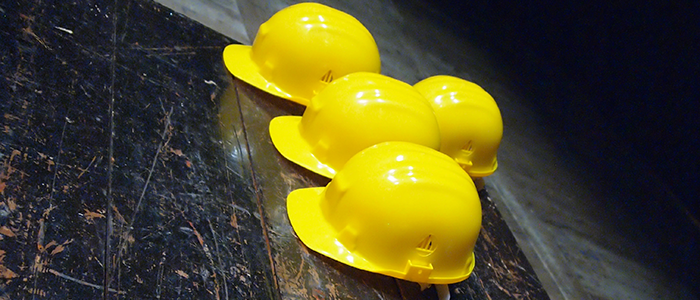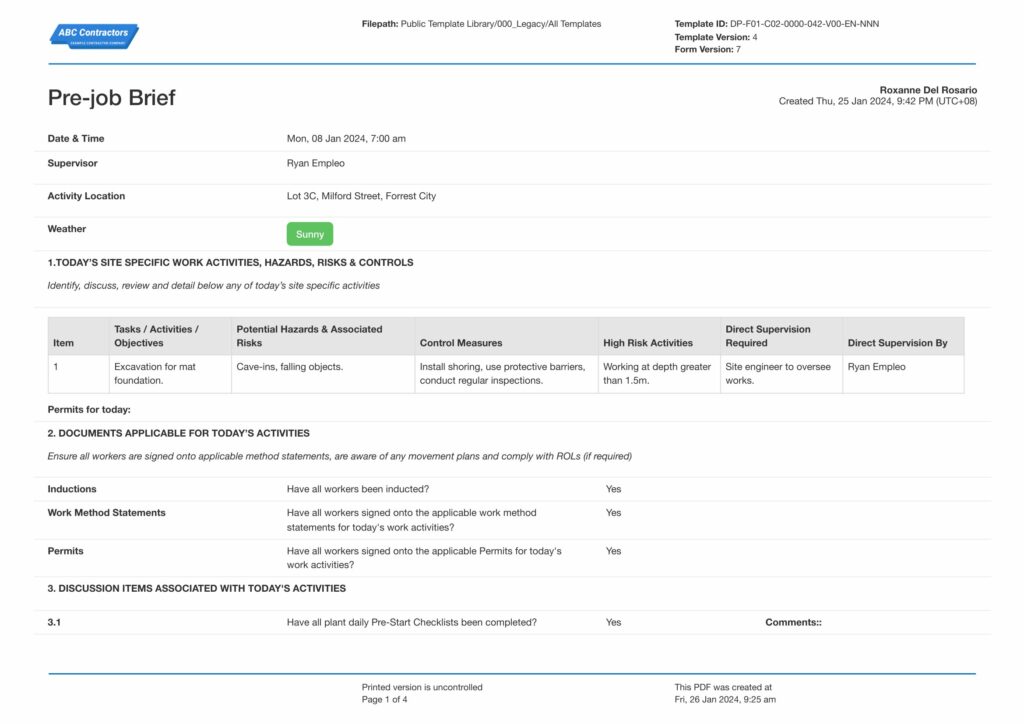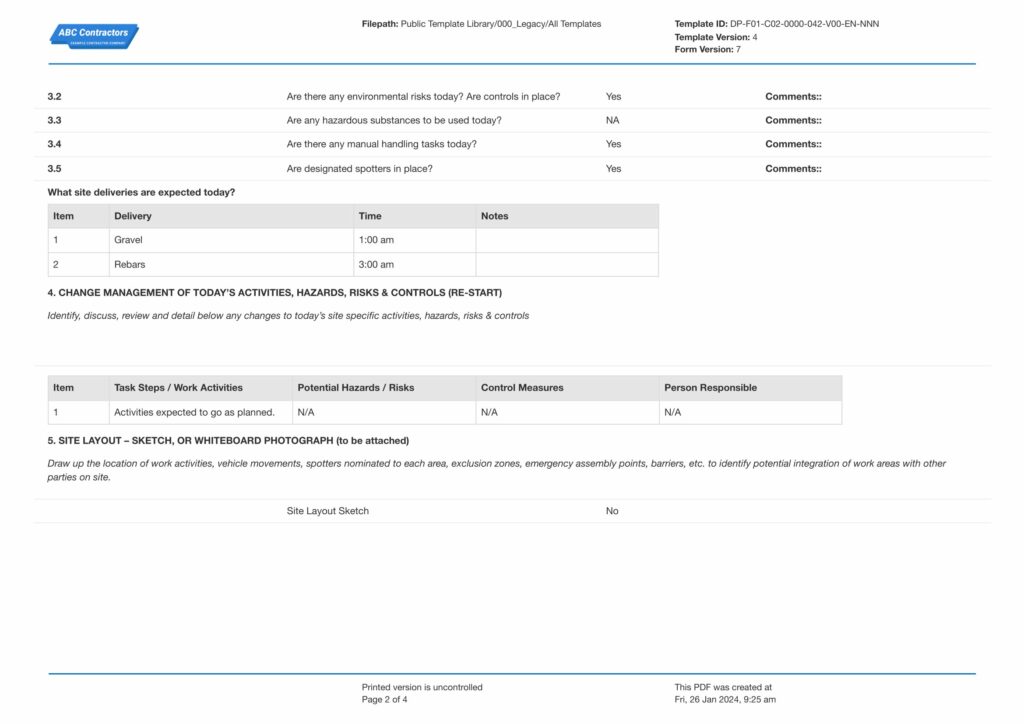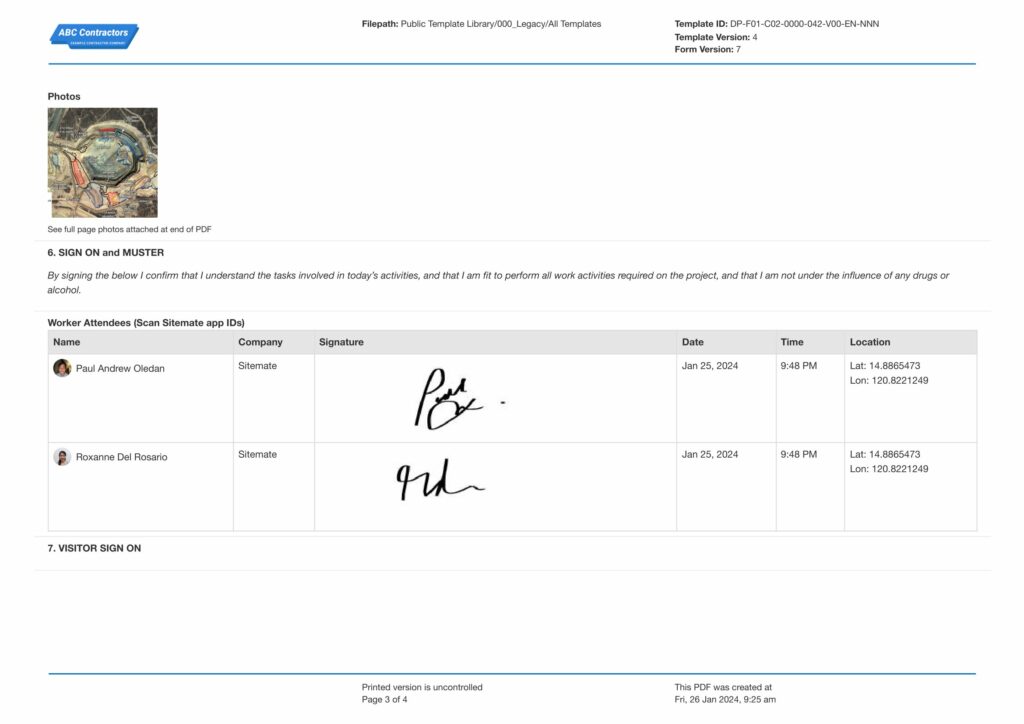Dashpivot Article – Pre-Job Brief Example
Pre-Job Brief Example
In this article, we'll walk you through a real-life pre-job brief example, showing you how to run one that gets the work started correctly and effectively every time.

Table of Contents
Article Summary
- A pre job brief is a checkpoint for safety, risk management and communication, plus a Pre-Job Briefing checklist as guide before work begins.
- Conduct an effective Pre-Job brief by pivoting to these focus areas: purpose, timing, content, participants, frequency, and interaction.
- Understand the nature/type of the work, go beyond the basic, and incorporate other key elements in to your pre-job briefs like checklist, sketches, and tables.
- OSHA has now turned Pre-Job Briefs from static to dynamic (and living) safety documents, meaning as work circumstances change, so should the document.
What makes a Pre-Job Brief essential before work begins?
Before you start any job, you need to know what you need to work on, like instructions, and pre-checks on the type of job and equipment you need to use. A Pre-Job Brief contains these two elements, but it is more than just these two – it contains instructions, pre-checks, risk-assessments, and open discussions. It’s different from a toolbox talk, too, which is more of a routine safety discussion.
A Pre-job brief is task-specific, which means before working on a task, you need to go through the instructions, do pre-checks, conduct a risk assessment, and perform open discussion between workers involved in the task.
A pre-job brief is like a checkpoint, that makes sure everything and all the plans will be actioned accordingly, correctly, safely, and efficiently. It’s a live discussion that is recorded by using a form or a checklist, for documentation purposes. Workers who will be directly working on the tasks need to be briefed on what needs to be done, how they should be done (safely), and who specifically will be working on certain tasks. Team leaders align the workers on the hazards and safety measures associated with the task, and keep everyone focused on setting safety as the main priority.
Ultimately, a pre-job brief improves communication and coordination, reduces the changes of accidents and fatalities, and promotes safety and accountability.
Pre-Job Brief Example - what format should a Pre-Job Brief follow?
The formatting of a pre-job brief depends on the type of industry you’re in, but it normally and typically includes a job scope, who is in charge of the task, the hazards identified through risk assessments, control measures, PPE, and emergency procedures. It could have all that or remove a few and add a couple of sections that align with your company and type of work, which makes absolutely a lot of sense to have a fully-editable and tailor-to-fit type of Pre-Job Brief format, like the example format shown.
Let’s say, you’re expecting deliveries in a specific task, for example an excavation task. You can add in a section table where you can list down the expected deliveries and even add a checklist of documents that were used and fulfilled prior to starting the task, and many more, which you can see in the perfect example below.

Use this Pre-Job Brief for free
How do you conduct an effective Pre-Job Brief?
Conducting an effective Pre-Job Brief means you set the strict tone and structure for the work ahead, and build a workaround that keeps everyone safe, and the work process faster and efficient. You’re providing clear instructions that set proper communication between workers and proper preparation for a potential risky work ahead. Here are focus areas you need to define first so you can conduct an effective Pre-Job Brief:
Purpose
Everyone needs to understand why a task should be done, the gravity of the work, how long it’s going to take, the goals, what success looks like, and how this task is essential for the bigger project.
Timing
It might seem trivial, but it’s key to take into account the proper timing of the job or work. We’re talking about what the weather is like during the day or week or duration of the work, if everyone in the team is available, if all permits have been submitted and approved, if everyone else (non-task workers) are ready for that task, or they need to clear out, so the workers can do their job, etc.
Content
Of course, tasks and jobs will always require some sort of tools and protocols, meaning you need to follow certain steps. All workers and anyone involved must be briefed with this information: procedures, equipment, and any other compliance requirements.
Participants
Only persons who are qualified to do the job, are allowed to do the job. It’s a simple and strict rule to make sure everyone is safe. Additionally, those who are qualified already know their role – you don't need to teach them what to do. Furthermore, it should be properly established who they directly report to and how their individual tasks affect one another or another separate task/work. There should be a clear and transparent chain of responsibilities.
Frequency
Naturally, jobs that happen routinely often require attention, even though the workers know what they’re doing like the back of their hands. However, those tasks or jobs that rarely happen, need extra attention.
Interaction
It’s always encouraged to communicate properly between team members, and everyone should speak up if they have concerns, especially if it’s regarding safety and health.
All of these focus areas are extremely important, but if you don’t know how to communicate these areas to each other within the team and outside, even all of this preparation will go to waste. Essentially, the team leader should communicate these elements by using a pre-job brief document, which depends on how your company structures it, could be a document, form, or a checklist – or all in one.
Read more about what OSHA has to say about Pre-Job Briefs and what they require from companies as best practices in this article OSHA Pre Job Brief Requirements. It also includes how a Pre-Job Brief differs from a Toolbox Talk.
Other key elements for your pre-job brief document
Based on the example earlier, you should already have an idea what a Pre-Job Brief looks like. Like in the example, which is a routine work, it contains a section table for expected deliveries. It’s much easier to communicate between team members the items needed for the work to be done. We have that, but what other key elements should you put in your Pre-Job Brief document to go beyond the basics and depending on the type of job?
Like mentioned, the document may be a simple document or form that lays out all the necessary information, or it could be a checklist, or everything that. Here are some good ideas you can incorporate into a Pre-Job Brief:
Pre-Task Checklist
This one’s not a comprehensive type of checklist, rather, it’s a checklist of your checklists – like equipment checks, permits are secured, calibrations for tools are checked, etc. It’s the general checklist of all the comprehensive ones.
Permits Checklist
If you’ve got a bunch of permits needed for one work to be done, it’s best to make a separate checklist for it in your Pre-Job Brief.
Site Sketch
If necessary, you could place a sketch of the site so you can identify the access points, exists, hazardous zone, etc. that the workers need to know before starting work. These could also be where they can place tools or equipment, where the other workers are placed, first aid and emergency locations, and other more reasons.
Deliveries/Materials Table
This was already in the example, but you can add in more columns like whoever received the items, who are responsible for them, where they’re stored.
Who should be the one preparing these documents and conducting the actual Pre-Job Brief, then? Dig a deep more by reading this article, Who Should Conduct a Pre-Job Briefing?, to answer the important questions after establishing what your pre-job brief document looks like.
Shifting to dynamic safety management with Pre-Job Briefs, as per OSHA
OSHA has recently highlighted another focus area where Pre-Job Briefs can be applicable. This new practice basically means that pre-job briefs are like living documents, not a one-time thing for an ever-changing and dynamic work. Instead of the usual way of treating it like a static one-time procedure, it's a dynamic safety document. When circumstances change, so should the pre-job brief.
If in any event that the general work changes, or there are unforeseen hazards that arise at the last minute, or any drastic changes, the work must be postponed. The team must conduct another risk/hazard assessment that aligns with the changes and a revised Pre-Job Brief before starting work again.
Improving pre-job briefs, safety and communication using digital solutions
You already know what a Pre-Job Brief looks like, and this document is highly tied to safety, risk management, and communication.
In order to improve safety procedures, enhance communication between team members, and stay confident with the work that you’ll be doing, digital solutions have more than being the faster option as the solution.
With safety procedures, there are chances of overlooked risks due to delays, confusion, and miscommunication among workers. And last-minute verbal announcements and changes don’t help at all. Digital solutions are simpler and more reliable way that allows fast-tracked communication and visibility. Teams will stay aligned because there aren’t any scattered checklists, papers, and documents that are hard to track. Seamlessly streamline any health, safety, environmental, and quality or even field reporting processes.
Any type of work in high-risk industries will always be aligned of some sort of risk, and it’s our job to make sure we define the possible risks before any work starts. It’s not just about defining them, too, but making sure everyone is aligned and informed of the potential risks. By developing streamlined processes by using digital solutions like this Risk Assessment Software for Industrial Companies, it’s so much easier to document risks, develop control measures, and assign persons who are responsible for taking care of those. You can so easily make your hazard assessment way easier with autofilled fields, tables, charts, and many more – all accessible in your mobile devices, tablets, and computers.
Not only that, there’s a reason why regulatory bodies require permits – to make sure everything is in check, regulated, and in compliance. Having a digital system like this flexible Permit Management Software ensures that critical and high-risk works begin with the proper oversight.
Summary of a Pre-Job Brief example
This Pre-Job Brief example serves as a guide and a starting point on how you can structure your own pre-job brief documents, forms, and checklist.
With the focus areas mentioned, you can so easily tailor to fit the contents of your pre-job briefs, that perfectly aligns with your company’s procedures, protocols, measures, and even with the type of work. Other additional elements in your pre-job brief document may also vary depending on the requirements, like having a general checklist, list of permits, tables, and even a site sketch.
Remember, whenever there are drastic changes in the work, you must also be inclined to conduct another risk assessment and a pre-job brief. This way, it makes sure that no hazards will slip past through the assessment and briefings
Frequently Asked Questions
Is a Pre-Job Brief mandatory under OSHA regulations for all industries?
OSHA expects high-risk industries to conduct, at the bare minimum, risk and hazard management, and safety checks and briefings – and a pre-job is one of the documents that meet those requirements. Although OSHA doesn't explicitly require specifically a Pre-Job Brief, it fully aligns with the core safety standards of OSHA.
How are digital tools changing how people manage Pre-Job Brief and other safety and quality documents?
Digital tools are transforming Pre-Job Briefs and other safety and quality documents by replacing papers and spreadsheet with digital solutions like Dashpivot. Teams can easily fill out documents and forms on the go using their mobile devices and tablets, store data in a secure database, keep everyone aligned with the latest versions, track compliance in real-time, and many more. Overall, operational efficiency and accuracy improve, there are fewer delays in tasks/jobs, and communication is better and quicker than ever.
Does Sitemate offer ready-to-use Pre-Job Brief templates and other HSEQ documents?
Yes – Sitemate has ready-to-use and easily editable templates to streamline Pre-Job Brief templates and even other HSEQ documents. Companies in any industries like construction, manufacturing, maritime, oil & gas, are even using these templates now to streamline all of their health, safety, environmental, and quality documents, including leveraging a fully-equipped risk assessment software for industrial companies and a flexible permit management software to assist in smooth and quick approvals.
Related resources

Safety Toolbox Talk
This toolbox talk template is quick and easy to complete and signoff on site, and keeps all of your toolbox talks neatly organised and professional.

Job Hazard Analysis
Easily complete a JHA on any device, and then keep all of your job hazard analyses neatly organised and searchable.

OSHA Form 300 & 300A
Maintain your log of injuries and illnesses and your 300a summary with this free template.



